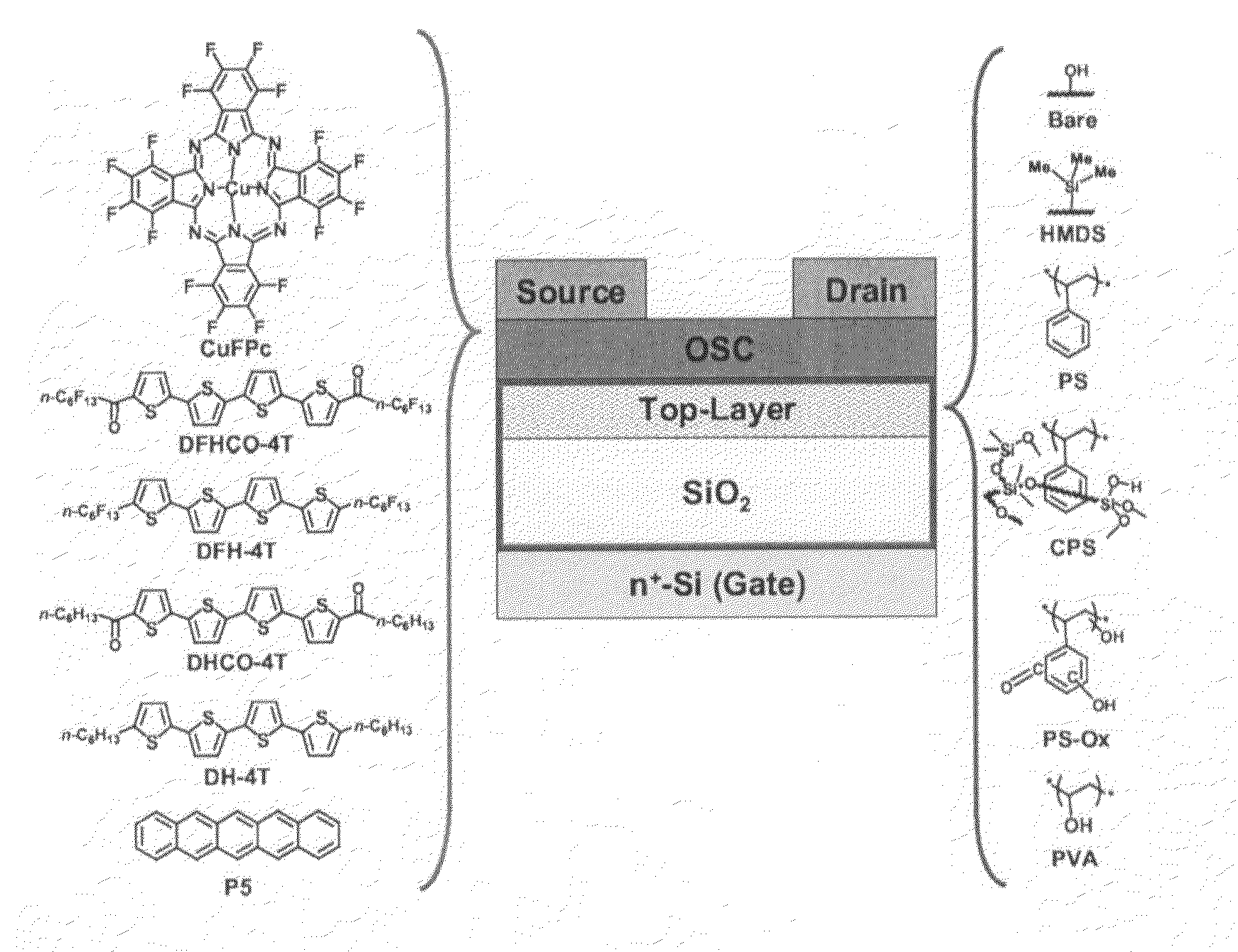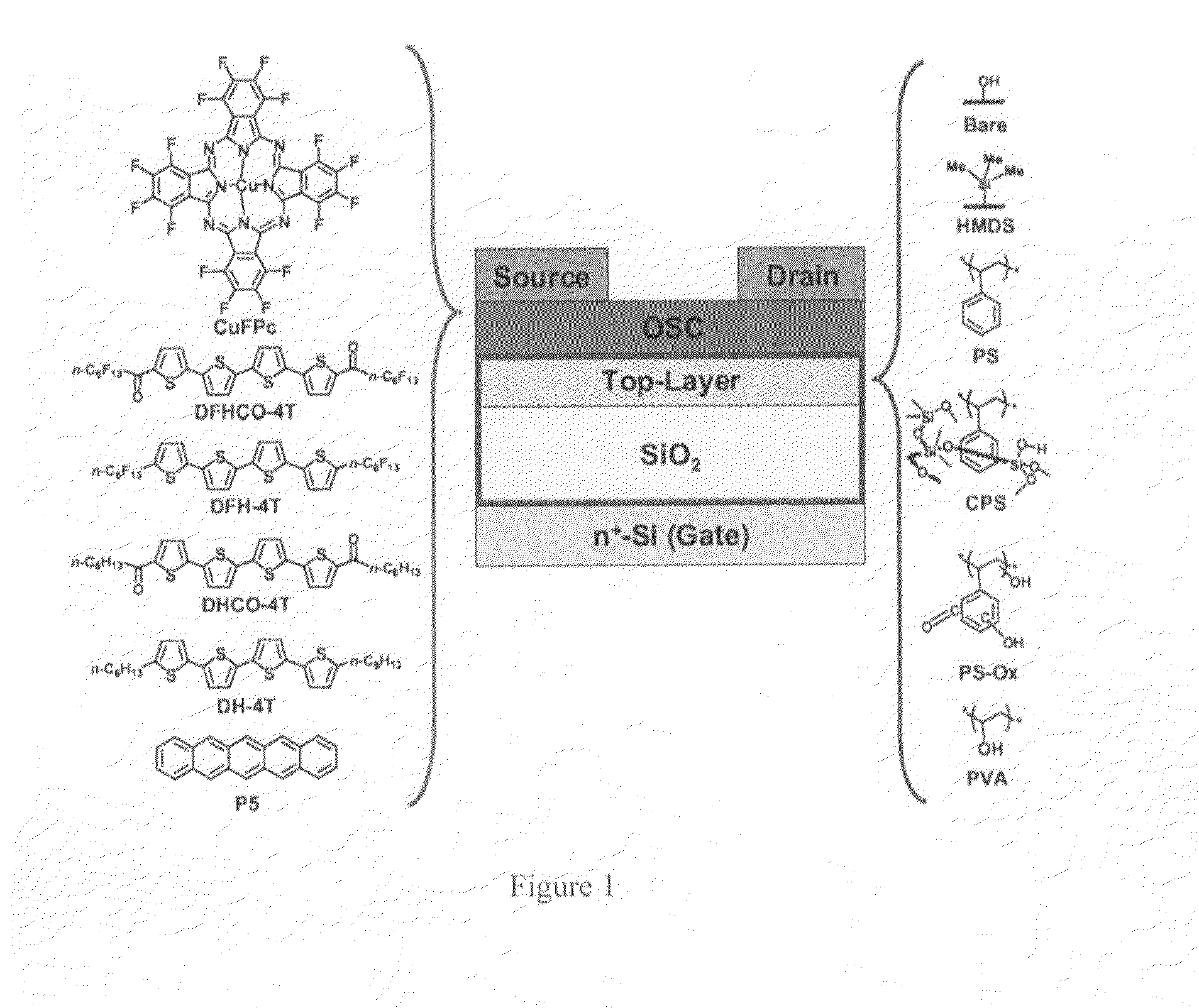Gate dielectric structures, organic semiconductors, thin film transistors and related methods
- Summary
- Abstract
- Description
- Claims
- Application Information
AI Technical Summary
Benefits of technology
Problems solved by technology
Method used
Image
Examples
example 1a
Bilayer Dielectric Fabrication and Characterization
[0068]All of the bilayer dielectric samples were fabricated on p+-Si / SiO2 (300 nm) substrates. The top polymer layer was deposited by spin-coating according to the procedure described above. The polymers employed in this study are polystyrene (PS), a crosslinked polystyrene blend (CPS), and polyvinyl alcohol (PVA). Therefore, the following dielectric structures were fabricated / investigated and are identified here as the following (FIG. 1, right): are, p+-Si / SiO2 (300 nm) treated with O2 plasma before use; HMDS, p+-Si / SiO2 (300 nm) treated with HMDS vapor before use; PS1, p+-Si SiO2 (300 nm) / PS (24 nm); PS2, p+-Si / SiO2 (300 nm) / PS (31 nm); PS3, p+-Si / SiO2 (300 nm) / PS (71 nm); PS4, p+-Si / SiO2 (300 nm) / PS (150 nm); PS-Ox, p+-Si / SiO2 (300 nm) / PS (24 nm) treated with O2 plasma; CPS, p+-Si / SiO2 (300 nm) / CPS (13 nm); PVA, p+-Si / SiO2 (300 nm) / PVA (115 nm). These samples allow investigating the effects of a wide range of surface energies, as...
example 1b
[0069]Typical leakage current densities of the surface-modified substrates are identical to that of pristine p+-Si / SiO2 (Bare), −9A / cm2 at E˜4 MV / cm, as measured in MIS structures (M=Au, 200×200 μm contact area). The insets of the AFM images in FIG. 2 show that the current density versus voltage plots for the thinnest (Bare,) and the thickest (PS4) insulators are identical. This result demonstrates that the leakage current densities at the maximum OTFT gate fields employed here (˜3.3 MV / cm) are dominated by the bottom SiO2 layer. AFM micrographs of the bilayer films reveal that with the exception of CPS (RMS roughness ρ˜0.9 nm), all dielectric samples exhibit very similar topographies characterized by very smooth AFM morphologies with ρ=0.1˜0.3 nm, slightly larger for the thicker PSn films (Table 3). Representative AFM images are also shown in FIG. 2. Consequently, the differences among OTFT performance parameters (vide infra) can be mainly attributed to the chemical nature of the d...
example 2a
Thin-Film Transistor Fabrication and Characterization
[0071]As discussed above, studies on OTFTs fabricated with bilayer dielectrics (and most of those using a single polymer dielectric layer) have been limited to pentacene devices. With the goal of more fully understanding structure-property relationships governing diverse organic semiconductor-dielectric interfaces, the OTFT performance characteristics of six semiconductors on nine bilayer dielectrics were analyzed. The semiconductors investigated here (FIG. 1, left) were selected to span all possible combinations of majority carrier transport type observed on untreated / HMDS-functionalized SiO2 dielectrics and are: i) N-type. Perfluoro-copperphthalocyanine (CuFPc), α,ω-diperfluorohexylcarbonyl-quaterthiophene (DFHCO-4T), and α,ω-diperfluorohexylquaterthiophene (DFH-4T); ii) Ambipolar. α,ω-Dihexylcarbonyl-quaterthiophene (DHCO-4T); iii) P-type. α,ω-Dihexylcarbonyl-quaterthiophene (DH-4T) and pentacene (P5) (FIG. 1). Pentacene was in...
PUM
| Property | Measurement | Unit |
|---|---|---|
| Fraction | aaaaa | aaaaa |
| Area | aaaaa | aaaaa |
| Area | aaaaa | aaaaa |
Abstract
Description
Claims
Application Information
 Login to View More
Login to View More - R&D
- Intellectual Property
- Life Sciences
- Materials
- Tech Scout
- Unparalleled Data Quality
- Higher Quality Content
- 60% Fewer Hallucinations
Browse by: Latest US Patents, China's latest patents, Technical Efficacy Thesaurus, Application Domain, Technology Topic, Popular Technical Reports.
© 2025 PatSnap. All rights reserved.Legal|Privacy policy|Modern Slavery Act Transparency Statement|Sitemap|About US| Contact US: help@patsnap.com



